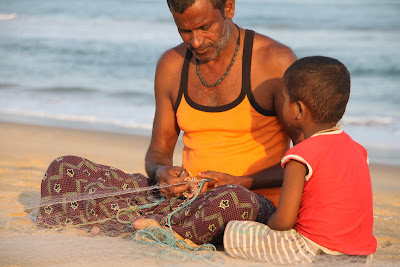Until our households are able to build their skills to engage in more productive livelihood activities that can help them to generate increased income, through the Livelihood Pathways project, we have identified ways to help households meet their immediate consumption needs in the interim. The first is to link households to government welfare schemes that provide them with a minimum guaranteed wage employment or the equivalent wages, food rations, and other cash tansfers. The second is to train members of the household to engage in low skill activities, such as kitchen gardening and incense stick rolling, and link them to these local markets to generate relatively small but immediate and stable incomes. Avinash Kumar, our project manager in Gaya, blogs about these activities here. Special thanks goes to Julia Arnold for her immense editing contributions.
Building Skills, Building Confidence: Ultra Poor Women in India Are Taking a Step Toward Self-Reliance
Asha Devi’s eyes sparkled as she rolled agarbatti (“incense sticks” in Hindi) for the first time. Asha is a member of an adapted self help-group (ASHG) in Pali, a village in India’s Bihar state, where the Livelihood Pathways for the Poorest, a joint project of Grameen Foundation’s Solutions for the Poorest group and BASIX/The Livelihood School, is being implemented. The sparkle in Asha’s eyes reflects newfound self-confidence and pride that by selling handmade agarbatti, she will be able to supplement her family’s income.
Nearly 100 women from six village ASHGs participated in our week long training. Agarbatti rolling, which is a common activity in almost all of the villages in the Gaya district of Bihar, is one of two income-generating activities being promoted through the project. These activities require simple skills and provide modest increases in income to help households meet their immediate consumption needs. As the clients’ confidence levels and skills increase, the project team will transition them into entrepreneurial income generating activities, such as poultry farming and goat rearing, which require higher initial capital investment and skill sets but can significantly help fill income gaps throughout the year.
The agarbatti rolling training was unique not only because it was the first time women from the poorest families were receiving it, but also because it was the first time local women were given a leadership role to train their fellow community members. The experience of having a local woman train them in this skill helped increase the participants’ confidence, leaving them optimistic about their prospects and ability to contribute to their families’ income. While agarbatti rolling is common in the region, many of the households participating in our project had never done it because they live in relative isolation, making it more difficult for them to access agarbatti agents and vice versa. Instead, they have depended largely on wage labor from agriculture production, construction work, and road building.
Faced with very unpredictable and insecure income sources, these families have not had the luxury of time nor the opportunity to experiment with an entrepreneurial activity. In fact, these households often lack the necessary self-confidence to take up and learn a new activity, even such low-skill ones as agarbatti rolling. One of the aspects of the project is building the self-confidence of the members and, which, thus far, has been successful.
This training is the beginning of a change in this aspect of these women’s lives. As their self-confidence grows and they see their income rise, this positive change cycle will encourage them to seek out other opportunities. As they move forward, our team will work with them to continue on this path.









































































































